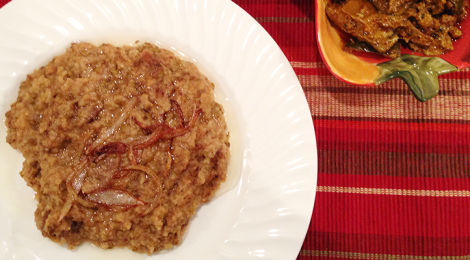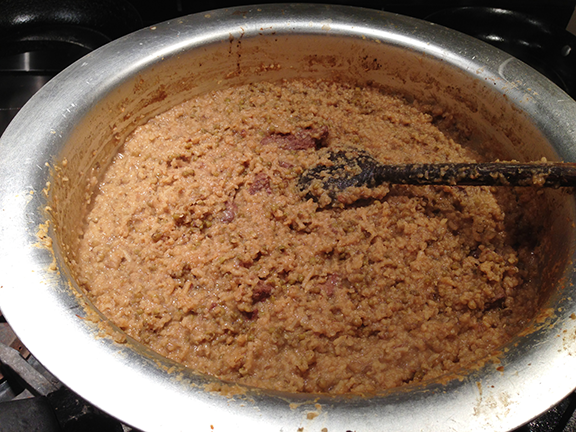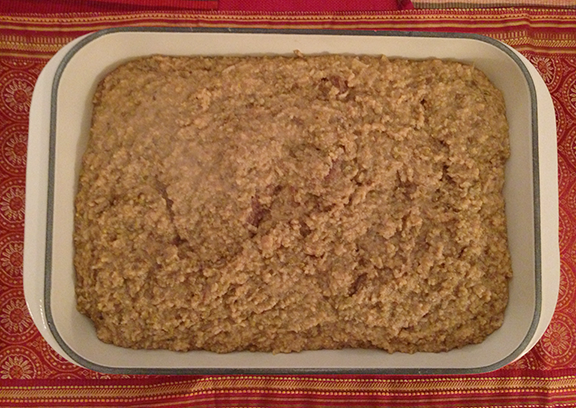
Mother-in-law’s SHOLA!!!
This might sound like a bad Indian soap opera, but it’s actually a very well loved, Peshawari dish…that my mother-in-law made recently, so I was like, yay! Now I don’t have to make it and measure out all the quantities! So, I conveniently handed her the task of noting down all the steps for me. That she did, and we thoroughly enjoyed the delicious meal. It was so nice to have such a special dish handed to me on a plate, without my having to lift a finger! Nothing like mom’s cooking!
So, what exactly is shola, you might ask? Shola belongs to the khichri family, which includes khichri, maash pulao, and shola. Some people really like khichri, especially my mother’s side of the family, but if like me, you only ate khichri when things weren’t going so well for your tummy, then don’t worry, you can still love shola like I do. Because shola is to khichri what haleem is to daal. It’s fancy. And very, very special. And of course, as the name suggests, it should be fiery in terms of heat! As my brother says, unless there is smoke coming out of your ears while eating, it doesn’t qualify as shola!
The Peshawari, or Pishori culture that we grew up in, belongs to a simple people. It was very earthy and grassroot, with little attention to formality and protocol, and a lot of attention to (extended) family get togethers and laughter… as my uncle always says, gappan te shappan, khanay te peenaay, haasa te kheda! Don’t even ask me to translate! It’s impossible!
Peshawar is a small city, and when my parents’ generation was growing up there, it was also extremely close knit. Everyone knows everyone. That’s a fact. Every spare moment was spent getting together with relatives, near and far. All the (first, second, third) cousins playing outside in the wide open fields, or in the streets, if they were in the city, all the adults enjoying talking and the women preparing delicious but simple meals, and in all of this, sounds of laughter echoing far and wide.
And it’s this laughter, this unbridled expression of complete joy and enjoyment, that brings people together and creates a bond, and draws everyone in. So that people keep coming back to share that joy with abandon… that is what people used to look forward to.
Sometimes they would sit together and recite couplets, sometimes the women would sing songs, sometimes they would do the luddi (a folk dance). There was actually a time when all the girls started doing the luddi at a funeral in a room upstairs, where they were all together, believe it or not!!! We have fallen on the floor laughing at this story and it never gets old, and as crazy and unfeeling as it might sound, I think it seemed like the natural thing for them to do at the time! They were a bunch of cousins, all together under one roof, and they thought of something fun to do!
Ok, it’s bizzare, but some story huh? Only in my family…
The thing to take away from this, however, is that the family was one big cohesive unit and it was all about the shared moments and the good times! That was entertainment and relaxation, creating a lifetime of wonderful memories.
And all this happened over one or two dishes, made in a large quantity, rather than a large number of items. Someone would say, I’m making shola, and everyone would converge, and the only thing accompanying the bottomless pot of shola would be a bottomless bowl of raita! No fretting over a chicken dish, and there must be kababs, and a vegetable, and we have to order pizza for the kids! No.
A large dastarkhwan would be laid out in the great room, everyone would squeeze in together, cross legged, or… half of a cross leg. (Yes, there’s that style too, it saves space and I find it very comfortable, actually. I cannot possibly explain what it’s like. I just know that people think that I’m a contortionist when I sit that way.) Everyone would sit around, bowls of shola, yogurt and salaad (sliced tomatoes, lettuce, cucumbers, onions) laid out at regular intervals, and everyone eating using their fingers while holding their plate with the other hand.
I really enjoy that sense of an archetypal favorite dish. Recently, we got an invitation to a dinner, where the host had made paey. They were phenomenal, and I loved that everyone was there because paey are special, and we know it, and we were all there to savor every morsel of that outstanding dish! No one said… errr… I don’t like paey. They’re sticky. They’re messy. Everyone just got in there and dug in, and got their hands dirty, and had a great time. The entire atmosphere was different from the usual… it didn’t seem like anyone was there to impress anyone, which a lot of us are trying to do at dinner parties, especially as the hosts. There has to be x number of dishes, such and such serve wear, such and such presentation, etc, etc, etc.
Shola is that grand, quintessential item that brought families together for generations, and I hope it continues to do so, in our home and in yours.
This recipe makes a large quantity, enough for 8-10 hungry people. It is meant to be served as the only dish at dinner!
Shola
Ingredients:
- 2 lb boneless beef cubes
- 3 cups basmati rice
- 2 cups whole mung daal (green gram)
- 2 large onions
- 1¼ cups oil
- 2 tbsp minced garlic
- 2 tbsp minced ginger
- 4 tsp corriander powder
- 3 tsp cumin
- 2 tsp red chili powder
- 5 tsp salt
- 2 tsp garam masala
- 22 cups warm water
Method:
- Soak the rice and the green gram in separate bowls for about 2 hours.
- Slice the onions. Fry in the oil in a large, heavy bottomed pot until brown.
- Add the garlic and ginger. Stir fry for a few seconds. Add the meat and bhoonofy well. Add all the spices and salt and stir fry some more.
- Add 11 cups of water and bring to a simmer. Add the mung daal and cover and cook on medium low heat until the mung is very tender, but not bursting out of its peel.
- Add the remaining 11 cups of warm water and bring to a simmer once again. Drain the rice and add to the pot. Cover and cook on medium low heat until the rice is very soft.
- Now ghotofy- mix well for a few minutes using a thick, wooden spoon until the mixture is mashed together. Adjust the seasoning.
- Transfer to a serving dish.
Tempering
This is the most important step! Tempering enhances the flavor of the dish beyond belief!
Slice an onion and fry in 1¼ cups of oil until the edges start to turn brown. Pour the onions, along with the oil, over the shola.
Because of some health conscious guests, however, my mother-in-law served the onions on the side.
Notes:
Take care not to let the meat get so tender the it dissolves completely. If at any stage, you feel that it is completely tender and leaving it in will cause it to disappear in the dish, then remove it from the pot and keep aside in a covered container. When the shola is ready, mix the meat in. It should be visible and discernible.
Shola is sort of mushy but the texture of the rice and mung should be there. Do not use a blender or any kitchen appliances to mix it together.
Watch the consistency of the dish. It is thick, but not completely solid. Adjust the consistency with water right before serving. It will thicken as it sits. So don’t worry about the large amount of water that the recipe calls for.
Serve with endless raita, achar and a garden salad.
I almost forgot to mention! Shola is eaten with a spoon. Oh, and like haleem, it’s even better the next day!
Please ‘like’ Zabiha Bites on Facebook.











What a lovely recipe! The measurements you have used, are those proper measuring cups and spoons or just whatever you use in your kitchen like a teacup?
Thank you. All the recipes use standard measuring cups/spoons.
Is this ‘ghatey rice’?? My MIL has bought some ‘rice ‘ saying it’s for ghatey rwijey only? Do u have the recipe fr that?
Yes. Shola is also referred to as ghatey rujey.
the story of shola is more interesting than shola I love your stories more than the recipes keep on writing good stories along with yummy recipes.
i love shola, i have converted my in-laws to shola as well. i always have some boiled beef & broth in my freezer to make “emergency shola” (yup that happens). i always ask my mom to bring me “Swati” rice which are short grain & when cooked become a bit gooey. i personally never use basmati for shola, when i don’t have Swati rice, i make shola with medium or short grain rice.